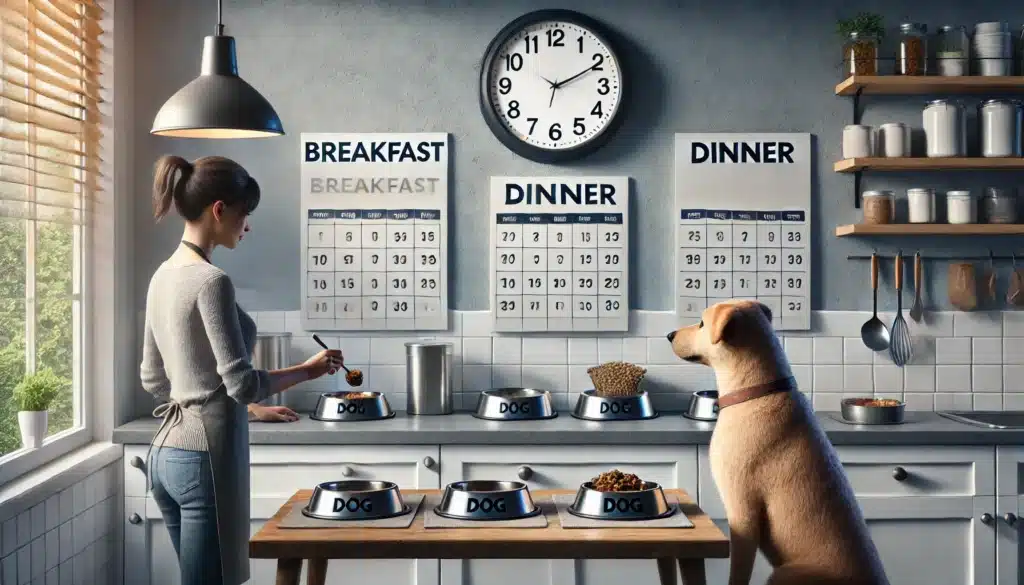Feeding your dog isn’t just about what you put in the bowl — it’s also about when and how often you feed them. While some dogs can thrive on one large meal, others do better with smaller, more frequent feedings.
So how many times a day should your dog eat? The answer depends on age, breed, size, lifestyle, and any underlying health conditions. In this guide, we’ll break it all down so you can build the best feeding schedule for your furry companion.
Why Meal Frequency Matters
Establishing a consistent feeding schedule helps:
- Regulate digestion and prevent bloating
- Maintain healthy body weight
- Support energy levels throughout the day
- Improve training and behavior
- Strengthen routine and reduce anxiety
Dogs are creatures of habit — they thrive on structure.
General Feeding Frequency Guidelines
| Life Stage | Meals Per Day |
|---|---|
| Puppies (under 6 months) | 3–4 meals |
| Adults (1–7 years) | 2 meals (sometimes 1) |
| Seniors (7+ years) | 2 meals |
Let’s explore each in more detail:
🐾 Puppies: 3 to 4 Meals a Day
Puppies are growing fast and burning energy constantly. They have small stomachs and need multiple meals to support:
- Muscle and bone development
- Brain and nervous system growth
- Healthy digestion and metabolism
Feeding schedule for puppies:
- Up to 3 months old: 4 meals per day
- 3–6 months: Reduce to 3 meals per day
- 6–12 months: Transition to 2 meals per day
Tip: Always use food formulated for puppies — it’s higher in calories, protein, and essential nutrients.
🐶 Adult Dogs: 1 to 2 Meals a Day
Most adult dogs do best with 2 meals per day — one in the morning and one in the evening. This keeps their blood sugar stable and reduces hunger-related behavior.
However, some large, low-activity dogs may do fine with 1 meal per day. Just be cautious — large, deep-chested breeds are more prone to bloat (gastric torsion), and splitting meals can help reduce that risk.
🐕 Senior Dogs: 2 Smaller Meals a Day
As dogs age, they tend to become:
- Less active
- More prone to digestive issues
- More sensitive to large, heavy meals
Feeding 2 smaller, balanced meals per day helps with:
- Weight control
- Easier digestion
- Joint health (through specialized senior formulas)
Always provide access to fresh water and consider adding soft foods if they have dental problems.
Breed and Size Considerations
🐩 Small Breeds
- Fast metabolism
- Prone to hypoglycemia (low blood sugar)
- Do best with 2–3 small meals per day
🐕 Medium and Large Breeds
- Moderate metabolism
- Typically thrive on 2 meals per day
🐶 Giant Breeds
- Risk of bloat
- Should be fed 2 smaller meals instead of 1 large one
- Avoid exercise right after eating
Activity Level and Lifestyle
- Highly active dogs (working, hunting, or sporting breeds) may need more frequent feedings or calorically dense food
- Sedentary dogs need fewer calories and controlled portions to avoid obesity
- Dogs with special needs (diabetes, gastrointestinal issues) may need 3–4 meals spaced evenly throughout the day — always follow your vet’s guidance
Should You Free-Feed Your Dog?
Free-feeding (leaving food out all day) can work in rare cases, but it’s not ideal for most dogs.
Pros:
- Convenient
- May reduce food guarding in multi-dog homes
Cons:
- Harder to monitor appetite or health changes
- Higher risk of overeating and obesity
- Inconsistent routine = behavior issues
Scheduled meals are better for training, discipline, and digestion.
How to Build a Feeding Schedule
Stick to the same times each day. Here’s an example for 2 meals/day:
| Time | Meal |
|---|---|
| 7:30 AM | Breakfast |
| 6:00 PM | Dinner |
Adjust based on your dog’s activity schedule and your lifestyle. Try to keep a 12-hour interval between meals for adult dogs.
Tips for Feeding Success
- Use a measuring cup to avoid overfeeding
- Stick to one designated feeding area
- Remove uneaten food after 15–20 minutes
- Add puzzle feeders to slow down fast eaters
- Track weight monthly and adjust portions as needed
Bonus tip: Dogs love routine. Feeding them at the same time each day builds trust and calm behavior.
When to Consult a Vet
Contact your veterinarian if your dog:
- Has a sudden change in appetite
- Refuses food for more than 24 hours
- Vomits or has diarrhea after eating
- Shows signs of bloat (distended belly, restlessness, rapid breathing)
- Needs a specialized diet (e.g. diabetic, hypoallergenic)
Feeding frequency may need to be adjusted based on medical conditions.
Final Thoughts: Feed the Dog in Front of You
There’s no one-size-fits-all answer — some dogs do great on two meals a day, while others need more structure or support. The key is to observe your dog’s energy, digestion, weight, and behavior — and adjust accordingly.
A consistent feeding schedule = a healthier, happier dog with a strong routine and fewer digestive issues. And that’s something both of you will benefit from every single day.







